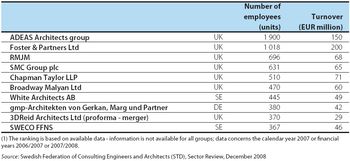Archive:Architectural, engineering and technical services statistics - NACE Rev. 1.1
- Data from December 2008 and January 2009, most recent data: Further Eurostat information, Main tables and Database.
Architectural and engineering activities covered
by NACE Group 74.2 include architectural consulting
activities (such as building design and
drafting, supervision of construction, town and
city planning, and landscape architecture) and
various engineering and technical activities related
to construction, as well as geological and
prospecting activities, weather forecasting activities
and geodetic surveying. Technical testing
and analysis activities (NACE Group 74.3) include
environmental measuring, testing of food
hygiene, buildings and equipment, as well as the
periodic testing of vehicles for roadworthiness. In
this article, these activities are referred to as
technical business services.
Main statistical findings
The ten largest architectural enterprises (groups) in the EU are presented, based on information compiled by the Swedish Federation of Consulting Engineers and Architects (STD). As can be seen, the United Kingdom dominated this activity in 2007, as the six largest groups were British. However, even the largest groups were relatively small, with only the two largest having 1 000 or more employees.
Structural profile
Some EUR 129.6 billion of value added was generated in 2006 by the EU-27’s technical business services sector (NACE Groups 74.2 and 74.3), from a turnover (SBS) of EUR 269.6 billion. This corresponded to 15.3 % of the total turnover for business services (NACE Divisions 72 and 74) and 14.5 % of the value added. There were 2.7 million persons employed across the 926.3 thousand enterprises that were active in this sector, equivalent to 12.4 % of the EU-27’s business services’ workforce and more than one fifth (21.2 %) of the business services’ enterprise population. Among the persons employed in this sector, 71.8 % were paid employees, the lowest level of this share among the business services sectors, indicating a high incidence of working proprietors and unpaid family workers. The United Kingdom contributed the greatest share (23.4 %) of value added in the EU-27’s technical business services sector, the second largest contribution being recorded by Germany (17.4 %). However, Germany had a larger workforce in this sector than the United Kingdom. In value added terms, the United Kingdom, Sweden and France were the most specialised Member States in these activities in 2006, as this sector contributed between 2.7 % and 2.8 % to national non-financial business economy (NACE Sections C to I and K) value added. Bulgaria (2005) was the least specialised in this activity, generating just 1.0 % of its non-financial business economy value added in technical business services, with Poland, Cyprus (both 2005), Slovakia, Portugal and Latvia also recording shares below 1.5 %.
Expenditure and productivity
The share of personnel costs (SBS) in operating expenditure was 35.0 % for the EU-27’s technical services sector in 2006, 4.5 percentage points below the business services average, but nevertheless far above the non-financial business economy average (16.1 %). Average personnel costs were relatively high, EUR 40.0 thousand per employee, while apparent labour productivity was EUR 47.2 thousand of value added per person employed, also above the business services average. The resulting wage adjusted labour productivity ratio was low, 118.2 %, reflecting the high average personnel costs. This was the second lowest ratio among the business services activities. Italy and Belgium both recorded ratios below parity (100 %) indicating that average personnel costs were higher than apparent labour productivity. Only in Greece was the wage adjusted labour productivity ratio for the technical business services sector above the national average for the non-financial business economy.
Data sources and availability
<description of data sources, survey and data availability (completeness, recency) and limitations>
Context
<context of data collection and statistical results: policy background, uses of data, …>
Further Eurostat information
Publications
Main tables
- Title(s) of second level folder (if any)
- Title(s) of third level folder (if any)
Database
- Title(s) of second level folder (if any)
- Title(s) of third level folder (if any)
Dedicated section
Other information
<Regulations and other legal texts, communications from the Commission, administrative notes, Policy documents, …>
- Regulation 1737/2005 of DD Month YYYY on ...
- Council Directive 86/2003 of DD Month YYYY
- Commission Decision 86/2003 of DD Month YYYY
<For other documents such as Commission Proposals or Reports, see EUR-Lex search by natural number>
<For linking to database table, otherwise remove: {{{title}}} ({{{code}}})>
External links
See also
Notes
[[Category:<Category name(s)>]] [[Category:<Statistical article>]]

